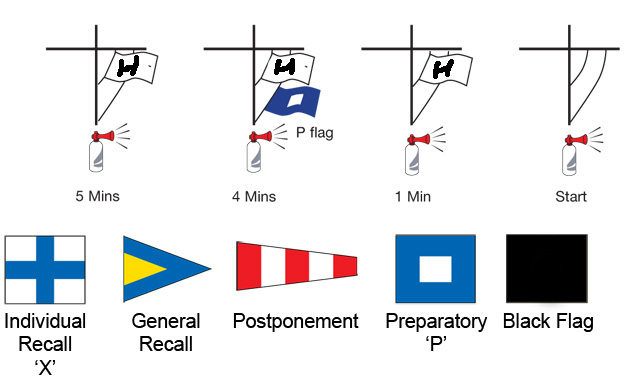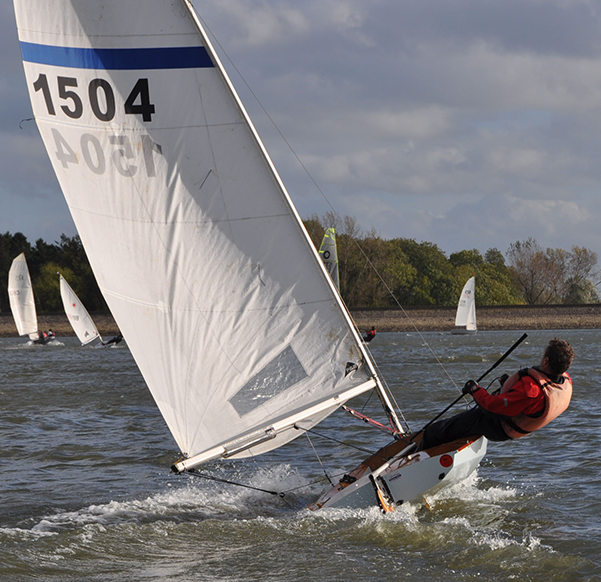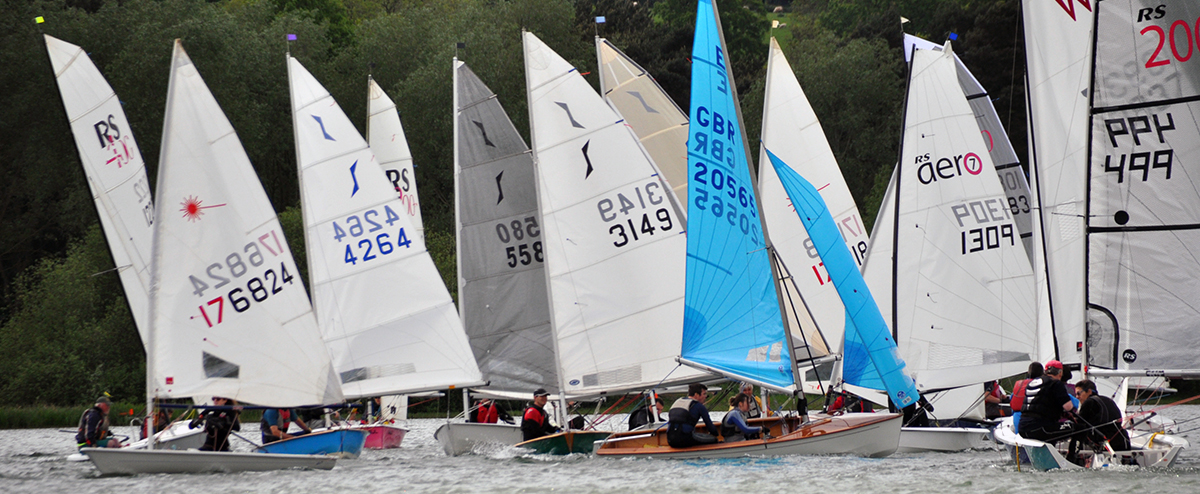
Racing Marks

Remember where our marks are:
- D = DAM, the dam end of the lake.
- G = The one nearest GUILSBOROUGH village.
- N = The one nearest NASEBY village (also happens to be NORTH)
- H = The one nearest HOLLOWELL village (often referred to as HOME).
- M = That would be the one in the MIDDLE (usually on the far-shore)
- B = BAY, the one nearest the boat sheds
- A = ARM, only usable when the reservoir is full.
The picture shows our general layout. They should always be in that order but not necessarily in that exact place - water levels and training courses might require the marks to be moved.
One pink mark (S) is often used to mark the other end of the START and finish line. It can also be our 'SPARE' mark so could turn up anywhere on the course!
Why you should Race.
Once you have learnt the basics of dinghy sailing and perhaps invested in your first boat you really have three choices as to how you spend your time on the water: racing, cruising or pottering around. Pottering around can of course be a lot of fun, but eventually many of us feel the need to do our sailing with more of a purpose. Having a go at club racing is a great next step for many of those looking to graduate beyond the beginner level.
Having to sail round a course that someone has laid out for you forces you to practise your skills on all points of sailing rather than always settling for an easy option or just drifting around aimlessly. Observing more experienced helms sailing the same course gives you a great opportunity to learn from the way they do things.
Do I have to be an experienced helm?
Not really. If you are confident enough to sail your boat around a predetermined course (typically Level 2 skills or equivalent) then you are ready to have a go at racing. At Hollowell we run a short ‘Start Racing" course that provides an ideal first opportunity to try racing to see whether you like it. Alternatively of course you can just turn up and take part in any of our weekend or Thursday club races.
Do I have to know the rules?
When you are taking your first steps in racing you can get a long way simply by knowing and observing the rules that require port boats to give way to starboard and windward boats to give way to leeward. And until you are more confident about who has rights of way when rounding the marks of the course, it may be better at first to give other boats plenty of room to allow them to go round the marks more closely. Once you understand the rules about this there won't be any need to keep showing other helms this courtesy though!
Do I have to let the Duty Race Officer know in advance that I want to take part?
It might help, if you did. This will allow the Race Officer to finish you before the lead boats (you might have to go all the way round the course again)! It would also help if you told the ADO who you are and your boat details as this helps with inputting the results on the computer.
The Course Board

The 'first leg' will (hopefully) be into the wind, so you should be tacking to the first mark. The example picture shows 'B' as the mark to aim for in this race.
The line itself will be from the yellow pole on the Committee boat to, either 'S' Start (pink buoy) OR sometimes a mark on the course, again it will be whatever is the last buoy mentioned.
The committee boat displays a board indicating the marks to be rounded in the race and in which direction they have to be rounded. Occasionally, we may show the word 'gate' or 'line' under a mark - this requires you go between certain marks (ie treat like a 'gate'). This will be to make the ADO's job easier, so it is usually found between the committee boat and what was the start line. Meaning you need to cross the 'line' every lap.
The letters on the board have either a red or a green background. RED - leave the mark on your PORT (left). GREEN on your STARBOARD (i.e. right) side. The board also shows the number of laps to be sailed.
The Start Sequence

This is for a handicap race (mass start)
H… flag goes up with horn sound - indicates 5 mins until start
P… flag goes up with horn sound - indicates 4 mins until start
P… flag comes down with horn sound - indicates 1 min until start
H… flag comes down with horn sound - indicates GO! GO! GO!
GOOD TIP: If you have a nice new shiny racing watch - set it for a 4 min start. You will then know after the first signal you have a full minute to press your start button!
Individual & General Recalls - If the Duty Officer can identify boats that has crossed the line early the Individual flag (with horn sound) is raised. The DO may (but not obliged too) call out the boats number. A general recall flag (double blast on the horn) is raised if there too many boats over the line early and culprits cannot all be identified. Basically, start abandoned - come back and start all over again.
Postponement - Often because the start line is not long enough and needs to be reset. Occasionally bad weather is imminent either way, not used very often by us. Can be raised at any time before or during the start sequence. Must be combined with a horn signal.
Black Flag - Replacing H flag in the start sequence means you have all been very naughty and the next boat to cross the line early will be disqualified. (We do sometimes use this flag).
FACT: Flag signals take presidence over horn signals. A horn signal from the boat (any number of blasts) actually just means 'Look at me'!
Shortened Course

International code Flag S, is used when a race has been shortened, either when the wind dies or the race is taking too long. It helps race officers to get a result, so that somebody wins, rather than nobody! We will often use this flag. Accompanies two horn sound when lead boat rounds the last mark before the finishing line. After the lead boat finishes all other boats crossing the line finish (Grand Prix style).
GOOD TIP: If you find yourself at the back of the fleet and approaching the finish line consider allowing the lead boat to overtake. If you cross the line in front you will need to do another lap. Judge this carefully!!!
Pursuit Racing

Cross the start line - with boats the same PY as yours!
Instead of starting the fleet all at the same time a Pursuit race sends boats off at different times - depending on their Portsmouth Yardstick (PY) rating. The slower classes are started first then the faster classes. In theory all boats should finish at the same time. A boat"s finish place is it's position in the fleet at the finish horn. You must know your PY for your boat before racing. A flip-over book with these numbers are displayed on the Committee Boat.
Round-up or down your 4 digit PY to make it a three digit number. When your number goes (ie flips-over) - YOU GO
For a full pursuit race these turn over at 1 minute intervals. For half-pursuit races these turn over at 30 second intervals. (With horn sounding each time)
All boats finish at the same time. You should note the sail numbers of the boats in front of you and behind you when the the Committee Boat indicates the finishing time.
The Thursday Ladder
An important part of Thursday evenings is the social side - a simple race with a nice meal and a chat in the clubhouse afterwards.
These are pursuit races of 35 mins duration for a ‘scratch’ boat. This is when ‘0’ is shown to the fleet.
HANDICAPS- Initial numbers are allotted by discussion and agreement between entrant and duty officer. Racers will have either a ‘plus’ time ‘ or ‘zero’ or a ‘minus’ time. Thereafter handicaps will be adjusted, based on the previous race, as follows 1st place time gets + 1 and last place time has -1. If a competitor’s initial handicap is revealed to be grossly wrong then a larger adjustment should be made so as to place them in the middle of the fleet in their next race.
START - The start will be between a boat and a designated mark with 5-4-1-0 countdown. This starts the race for the slowest boat with a ‘P’ flag and/or a sound signal. Thereafter boats will start at 1 minute intervals related to their handicaps. The time in minutes before and after the scratch boat start will be displayed. The time displayed will indicate the handicap of the next boat ie - when your numbers goes - you go.
FINISH - The race will be finished between a boat and a mark chosen to make the race as near as possible 35 mins form ‘zero’ for the leader. The DO may however ‘sweep up’ the tail enders by moving down the fleet.
ENTRY - Entrants should indicate their intention to race by recording on a sign-on sheet their boat class, sail number and handicap.

Basic Racing Rules
Here are some right-of-way rules for racing. Please do not be put off by them. They will ensure you have a more enjoyable race in relative safety!
PORT/STARBOARD: When boats on opposite tacks meet (i.e. their booms are on opposite sides of the boat), the port tack boat must keep clear. The starboard skipper may (but can choose not to) assert their right of way by calling 'Starboard'. If he has right of way you must take action to keep clear (i.e. pass astern or tack/jibe).
THE TACK: The tack is named for the windward side of the boat, i.e. the side opposite the boom. If you face forward and the right hand side of the boat is windward, you are on starboard tack. Otherwise you are on port.
WINDWARD/LEEWARD: When boats are on the same tack, i.e. booms on same side the following applies:
Windward boat shall keep clear
A boat clear astern shall keep clear
This rule also covers upwind downwind boats meeting.
CHANGING TACK: While you are tacking, you must keep clear of other boats that are not doing so. If you acquire the right of way over a boat near-by with a tack or jibe, you must give that boat reasonable room and time to react. You cannot force a nearby boat to tack because you have no rights until you have completed the tack.
AVOIDING COLLISIONS: Even when you have the right of way, you must try hard to avoid any collision.
PUSHING IN: The buoy room rule does not apply at the start line. Do not try to squeeze between a boat to leeward of you and a mark. Note that a Committee Boat that marks the end of a start or finish line is considered a mark.
LUFFING:A luffing boat may not pass beyond head to wind if there is another boat there.
START OVER EARLY:If any part of your boat or equipment is across the start line when the start signal is made, you must re-start. You will not be told that you were over the line by the Race Officer and if you believe you were over it is best to re-start. While returning to the start line you must keep clear of the other boats that are not returning.
DEFENDING AGAINST OVERTAKING BOATS: If a boat tries to pass you to windward, you are entitled to defend your wind by luffing up but must do so in such a way was to give the windward boat room to keep clear. A luffing boat may not pass beyond head to wind while the other boat is there. If a near-by boat tries to pass you to leeward on a reach or run, you are not allowed to make life even more difficult for that boat by sailing below your proper course to the next mark.
TOUCHING A MARK: If you touch a mark, you may continue to race only after getting out of the way of other boats and sailing a complete circle (a 360° turn).
RULE INFRINGEMENT: You are officially racing and therefore bound by the racing rules from your prep signal (4 minute signal) until you have cleared the finish line.
If you break the rules you are required to do two complete circles (720°). You may continue to race after getting out of the way of other boats and completing your turns.
If there is a collision, the rules (usually) require there to be a protest or a 720° Sometimes minor fouls may be forgiven but not if there is damage. If you are fouled and intend to protest you must hail 'protest'. If the offending party does a 720 then the matter can be forgotten otherwise inform the Race Officer at
the finish line whom you are protesting and once ashore fill out the protest form with in the time period specified in the Sailing Instructions.
OUTSIDE ASSISTANCE: If you capsize and are separated from your boat and are rescued by the safety boat you can return you to your boat and continue to race without penalty provided your boat does not gain advantage in the meantime





